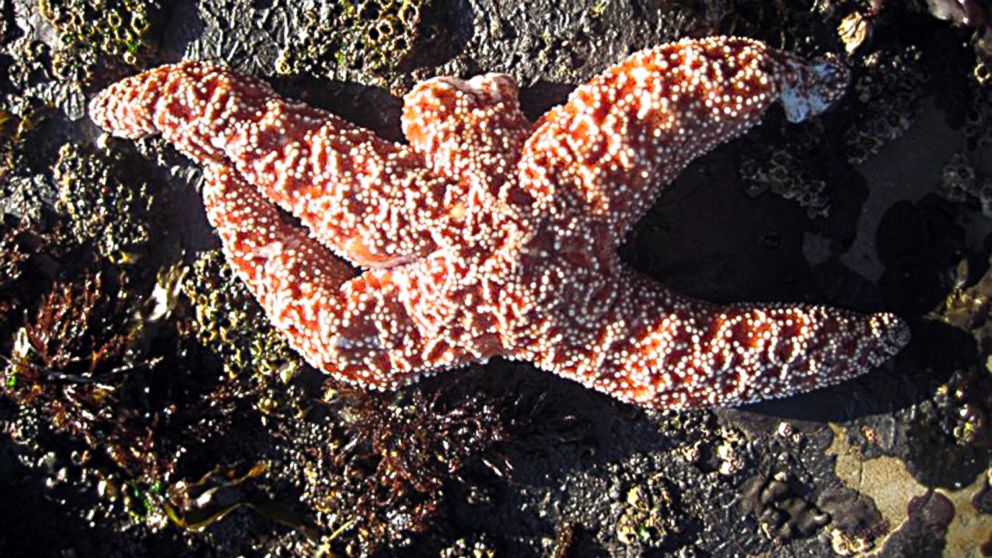West Coast Starfish Turning to 'Goo' Is Latest in Mass Wildlife Deaths
Seven curious cases from sea serpents to pigs found floating in a Chinese river.

Nov. 5, 2013— -- intro: Marine biologists have reported widespread starfish die-offs along the West Coast, precipitated by a disease that causes their arms to fall off and the creatures to disintegrate and turn to "goo."
"Sea star wasting disease," has been flushing out a vast number of a particular five-legged species from tide pools, even wiping out up to 95 percent of the population, the AP reported.
Along the western coastline stretching from southeast Alaska to Santa Barbara, the Pisaster ochraceus starfish, also known as the purple sea star or ochre starfish, are dying of the disease which causes white, abscess-like lesions to form and spread across their bodies.
Wasting disease has been reported before in southern California in 1983-84, but it remained localized then.
The starfish population die-off is the latest in a series of mass animal deaths to occur this year. Click through to take a look at some more curious cases of late.
quicklist: 1title: Giant Oarfish Wash up in Californiatext: Not one, but two giant sea serpent-like oarfish washed up on the beaches of southern California last month. The first discovery was made by a snorkeling marine scientist who wrestled the dead 18-foot monster (with help) to shore near Catalina, while the second so-called "discovery of a lifetime" was made in less than a week. The second oarfish measured at 13.5 feet, and was found washed up on a beach in Oceanside Harbor by bewildered beachgoers.
Test on the bizarrre fish failed to determine a cause of death.
The terrifying-looking and toothless oarfish is also known as a ribbon fish, possessing bony, silvery bodies and bright red-crested heads. They are thought to have spawned ancient folk tales about sea serpents.
media: 20781458
quicklist: 2title: Bees Turn Up in Parking Lottext: More than 25,000 dead bees were found scattered across a parking lot in Wilsonville, Ore., in June this year, amid rapidly declining honeybee populations across North America. The cause of the deaths was later determined by the Department of Agriculture to have been related to an insecticide used on trees to kill aphids.
Across the U.S., mass bee die-offs have been attributed to colony collapse disorder, in which bees abruptly exit the hive and do not return. Beekeepers have reported losing up to 90 percent of their bee colonies since 2006, but still have no idea what causes the disorder, although one theory is that the bees are committing a type of "altruistic suicide" to save their nest-mates from dying of disease.
media: 20781470
quicklist: 3title: Manatees Threatened by Algaetext: So far, 2013 has been the deadliest year yet for Mantees off the Florida coast. A bloom of toxic algae that draws out essential oxygen from the water has killed at least 769 of the blubbery, seal-like mammals. The algae, also known as red-tide, settles on the sea grass that manatees feed on, which when eaten, can cause central nervous system problems, including seizures and difficulty lifting the head to breathe, eventually leading to death.
This year's number of manatee deaths was nearly double of that seen in 2012, which was then reported at around 392. Manatees are a protected species and have been highly affected by urban coastal development, and constantly face the danger of being struck by boats.
media: 20781682
quicklist: 4title: Pigs Dumped in Chinese Rivertext: When 6,000 pig carcasses were found floating in China's Huangpu River in March, many of Shanghai's 23 million residents who receive their primary water supply from the river, were unnerved. The reports from health officials who later determined that the pigs were infected with a disease known as porcine circovirus, only served to deepen their fears, although the government claimed that the water had not been contaminated and was safe to drink.
It was thought that the pigs had been dumped in a hurry (and on the cheap) because of a recent government crackdown on selling diseased pigs.
media: 20781498
quicklist: 5title: Dolphins Die of Virus on East Coasttext: Hundreds of bottle-nosed dolphin deaths have been reported on the East Coast since July, which scientists are blaming on the outbreak of a dolphin virus similar to measles in humans.
The National Oceanic and Atmospheric Administration tested 33 of the approximate 333 dolphins that had washed ashore since July 1, and found the immune system-suppressing morbillivirus in all but one of them.
The dolphin die-off this year is the highest recorded since a similar scale viral outbreak in 1987 and 1988. As dolphins have very little resistance to the virus, NOAA scientists say they expect that wild populations will continue to die until spring 2014.
media: 20781484




